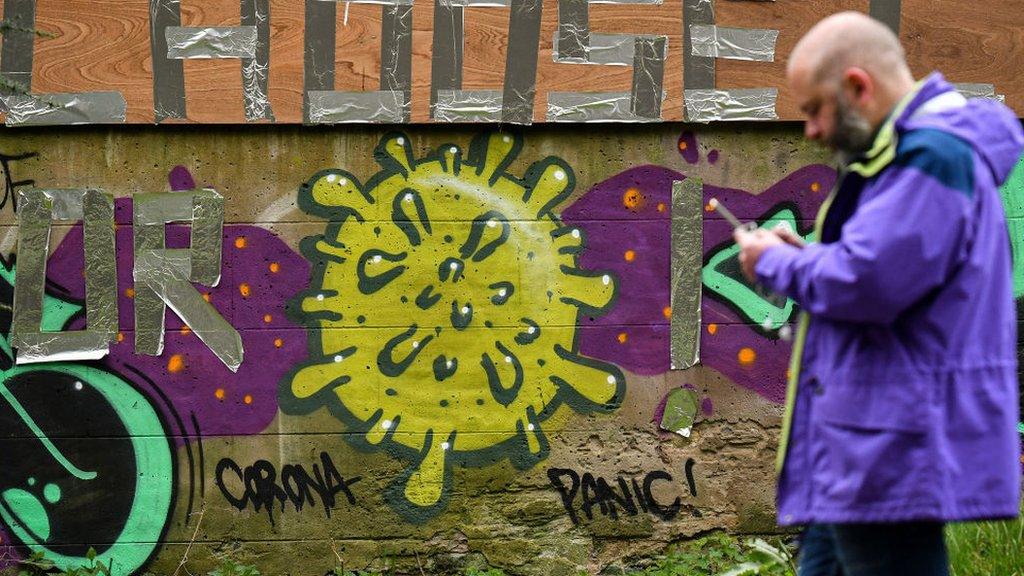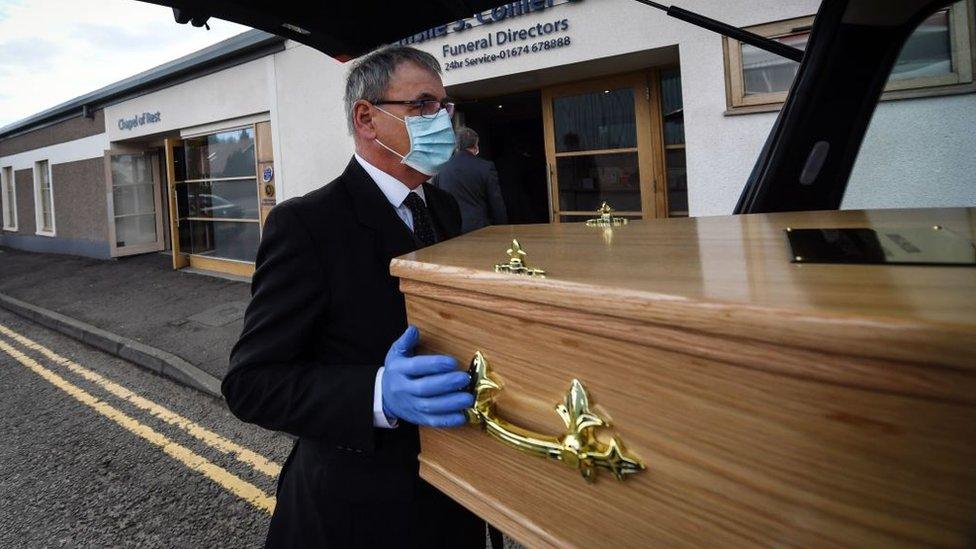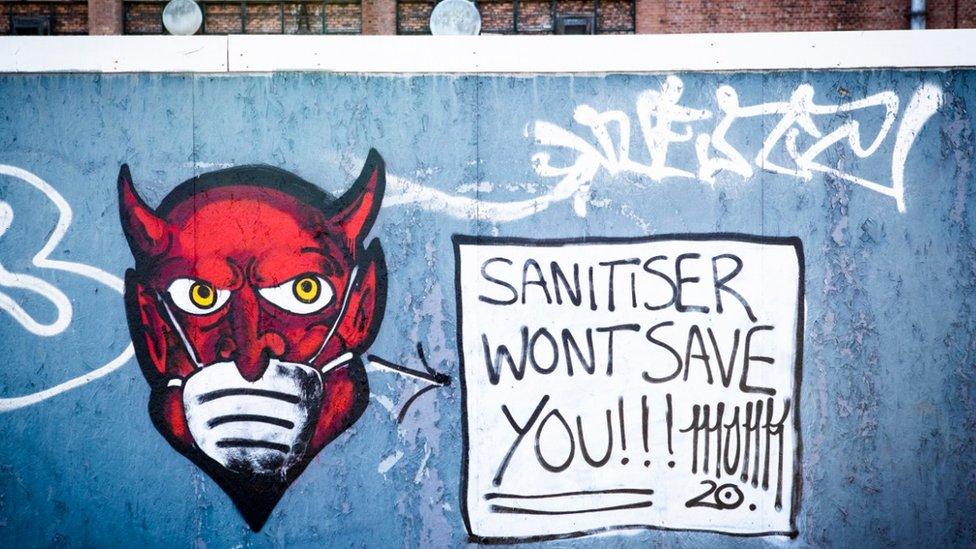Coronavirus: Demand for PPE 'caught everyone by surprise'
- Published

Jim Miller concedes there were flaws in Scotland's contingency plan for a pandemic, both in terms of supply and demand
The man responsible for procuring personal protective equipment (PPE) for the NHS in Scotland has admitted the global demand amid the coronavirus pandemic "caught everyone by surprise".
Jim Miller told me there had been flaws in Scotland's contingency plans for a pandemic when it came to the supply and demand of PPE but he insisted there was a success story to tell in how Scottish firms have adapted to produce protective equipment.
My journey to find that story begins in the Angus county town of Forfar where pink cherry blossom is tumbling down the empty streets.
The old market cross is quiet but in a factory on the edge of town, great machines are rumbling, churning out material to make masks, gowns and other products for the NHS.

Machines at Don and Low are churning out material to make masks, gowns and other products for the NHS

Ian and Brian work for Don and Low in Forfar
Don and Low suspended production and furloughed staff at its textiles plant when the lockdown began but its neighbouring non-wovens facility, producing material which will be woven into garments elsewhere, is busier than ever.
"It's been pretty hectic," says shift leader Ian Swan, who helped to oversee a transfer of production from industrial to medical products when national stocks of PPE for doctors, nurses and care home workers began to run short as the pandemic took hold.
"When I first started here 25 years ago, we used to make gowns for the NHS," recalls Mr Swan, but the work "all went to Korea and China".

The material made at Don and Low is used to make PPE

Jim Smith said further expansion is planned at the Angus firm
That is a familiar story in manufacturing as investors were lured by the promise of cheap labour in the east delivering cheaper products and higher profits.
The coronavirus though has exposed the dangers of such a system, leaving many rich Western nations with a shortage of critical equipment at a time of national emergency.
"Obviously, we've been let down by other countries because they need the capacity themselves," says factory worker Brian Winks.
The result is a scramble to bring manufacturing back home, leaving Don and Low, as one of the only non-wovens producers in the UK, barely able to keep up with demand.
"In the last eight to 10 weeks there's been significant growth," says plant manager Jim Smith.
'No end in sight to the growth potential'
The firm, which shed jobs last year, has now taken on extra staff and brought in new equipment. Further expansion is in the works.
"There is no end in sight to the growth potential," says Mr Smith.
"Hopefully we can help supply the NHS with all the PPE that they need," says Mr Winks. "And that makes me feel great to be honest."
From Forfar, the fabric hits the road, some of it destined for a factory in Fife which has also adapted rapidly to the pandemic.

Keela has switched to sew gowns for doctors and nurses

The first time Megan used a sewing machine was when she started at Keela
Keela in Glenrothes has switched from producing outdoor clothing for police and paramedics to sewing gowns for doctors and nurses.
It is a much simpler task but the volume is enormous - up to 40,000 garments a week - although logistical challenges have forced Keela to produce an adapted gown design, rather than the high-quality surgical gowns which the NHS usually orders.
More expensive
Both the firm and the health service insist the new attire is appropriate and safe and Keela and Don and Low recently struck a deal with the Scottish government to supply more than half of Scotland's weekly requirement of non-sterile gowns, meaning recruitment in Fife too.
"I started on Tuesday," says Megan Henderson, from Kingskettle, taking a break from stitching a seam. "That was my first time ever using a sewing machine," she says.
"I'm helping the NHS - that's amazing," smiles the 23-year-old, who applied for a job at Keela after the Golf Inn in Ladybank where she had been working closed at the start of the lockdown.

Kate Fernando says although producing PPE in Scotland is more expensive it is better than relying on imports
Keela's project manager Kate Fernando says the firm's operation is spread across several different premises around the country so production can continue even if one factory is hit by an outbreak of the virus.
"It's no longer about relying on imports. We're trying to be self-sufficient in Scotland," she says, although she admits that sourcing PPE locally, rather than importing it from Asia, comes at a cost.
"It's much more expensive. You can't deny that," says Ms Fernando although she is keen to point out that her machinists are paying taxes in the UK and spending money they earn locally.

A procurement arm of the NHS called National Services Scotland (NSS) runs this depot in Lanarkshire

From Glenrothes the gowns are loaded onto lorries which set off for a depot in Lanarkshire run by a procurement arm of the NHS called National Services Scotland (NSS).
Some 10,000 separate products - amounting to millions of individual items - are stored here. In the first weeks of the pandemic, when stocks of PPE were running low with some hospitals, GP surgeries and care homes complaining of shortages, this facility was under enormous pressure.
"So far we have issued close on 700 million items," says NSS director of procurement Jim Miller, with the depot moving from a 24/6 to a 24/7 operation, and taking on more staff.
Mr Miller concedes that there were flaws in Scotland's contingency plan for a pandemic, both in terms of supply and demand.
The speed at which the global supply chain started to clog up "caught everyone by surprise," says Mr Miller.
And "I think no-one really understood exactly how quickly the demand [for PPE] would rise," he admits.
"The real success story," he insists, has been the rapid switching of production to firms in Scotland like Keela and Don and Low.

Some health workers struggled to get the right PPE at first
Some nurses, doctors and care home staff who struggled at first to get hold of the right equipment might not recognise the description of PPE supply as a success story and even now there are concerns about the quality of some protective equipment.
"Inevitably, when you're talking about the volume of products that we have, there'll be some that come in that are not of as high quality as we would like," accepts Mr Miller.
Wouldn't it have been better, I ask, if NSS had anticipated these issues at the planning stage rather than scrambling to sort them out during a crisis?
"Whilst it's been very difficult to make sure we've got the supplies coming in, we've always had them coming in," he replies.

Mary Ralph and her colleagues say having the right PPE is essential
From the warehouse, the finished products take to the road again, heading to care homes, GP surgeries, hospitals and other facilities from Selkirk to Shetland.
At Glasgow's Queen Elizabeth University Hospital, charge nurse Mary Ralph is donning the battle armour that will protect her in intensive care - gloves (several pairs), gown, mask and visor.
It's hot, it's restrictive, it makes communication difficult and it can be frightening for patients, she says, but it is also essential.
"Oh it's vital, absolutely vital," says Ms Ralph, "That's what keeps us safe. It protects the staff. It protects the patients. So it is vital and it reassures you when you have your PPE on."

Mary Ralph says coronavirus is the "biggest crisis of [her] career"
For Ms Ralph and her colleagues, an efficient PPE supply chain could be a matter of life and death. In early March the World Health Organisation warned that a shortage was "endangering health workers worldwide"., external
Some experts now fear another surge in demand if businesses begin to compete with health services for PPE as lockdowns are eased around the world.
For now though, reckons Ms Ralph, Scotland is managing.
"I feel that we've had lots of assurances that there is actually plenty of PPE," she says, "I haven't been worried about that."
"This has been the biggest crisis of my career and I think we've coped really well, we've worked really well as a team," she adds.
"I think if we can survive this, we can survive anything."
- Published9 May 2020

- Published20 January 2021

- Published11 May 2020
